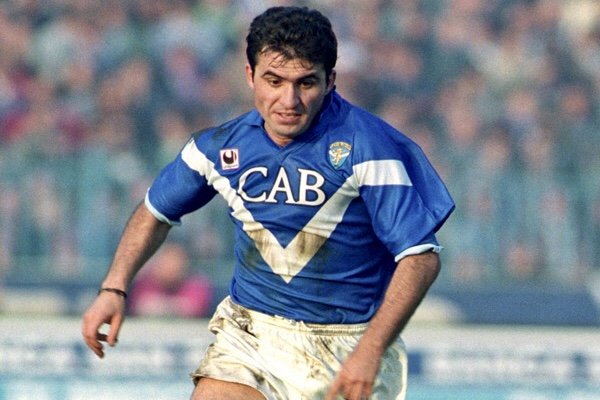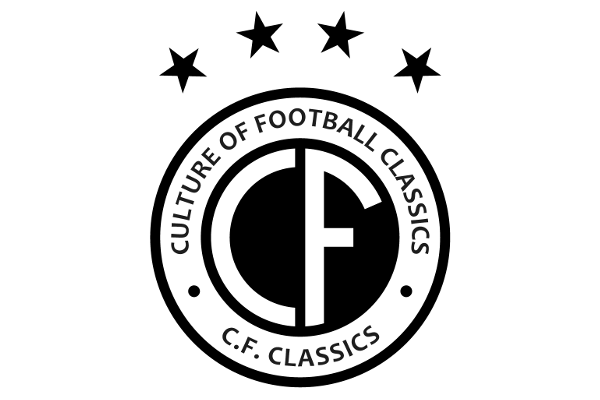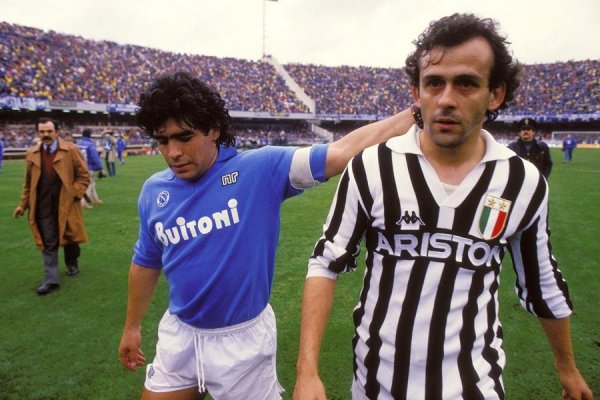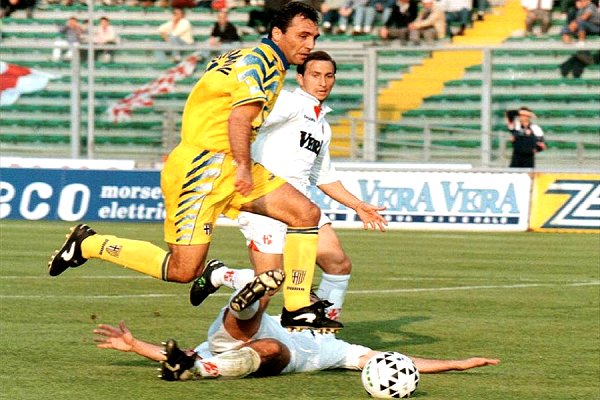Gheorghe Hagi Profile
Hagi started his football career in the late 1970s in the junior teams of Farul Constan?a. After impressing at Constanta he was selected to join the youth setup at Luceafarul Bucure?ti, which at the time was practically the national junior team of Romania, a place where the country's great footballing talents were developed.
After two years with Luceafarul, Hagi returned to Farul Constan?a and made his debut for their first team as a 17 year old in September 1982. Hagi's performances soon had some of Romania's bigger clubs linked with him, and at the end of the season he transferred to Sportul Studen?esc. It wasn't just Romania's top teams who'd been watching Hagi, the national team coach, Mircea Lucescu, had too, and Hagi made his debut for the Tricolorii against Norway in the summer of 1983. Hagi had four sensational years at Sportul, his goals and assists driving the club up the league to a runners-up position, the highest in the club's history, along with three seasons of UEFA Cup qualification. Such was his contribution that Hagi finished as the league's top scorer in 1985 and 1986. During his time at Sportul, Hagi was selected for the national team's appearance at Euro ‘84, coming on as a sub against Spain, and then starting against West Germany.
The start of 1987 would see a bizarre arrangement lead to Hagi's next step up the football ladder. Steaua Bucure?ti, Romania's largest club, had caused one of football's great shocks by beating Barcelona to lift the European Cup in the previous year, they were due to play Dynamo Kyiv in the European Super Cup in February and arranged for Hagi to join them with a one-match loan deal. After impressing them so much and scoring the only goal in the match, Steaua suddenly decided that they didn't want him to go back to Sportul and arranged for him to stay with them. It would prove to be a great move both for both Steaua and Hagi, the club winning three consecutive league and cup doubles from 1987 to 1989 and becoming a much feared side in the European Cup, reaching the semi-final in 1988 and the final in 1989. It was these European Cup matches, along with his performances for the national team, that would propel Hagi into the wider public eye. A number of top European clubs had been looking at him for a number of years, amongst them Italian giants Milan and Juventus, however, the Nicolae Ceau?escu regime that controlled the country were unwilling to let Hagi move away from the country at the time, and so the offers were forcibly rejected. It was only after the fall of the communist regime at Christmas 1989 that things changed and Hagi was allowed to move abroad. Shorty before Hagi had impressed at Italia ‘90, and an agreement was finally put in place for Hagi's transfer, Real Madrid being the destination after they'd offered 400m pesetas (approx $4m). His stats when he left Steaua were incredible; not only had provided umpteen assists for his teammates but he'd got a phenomenal goal scoring rate himself, netting 98 times in 107 appearances for the club across all competitions.
Hagi had two seasons at the Bernabeu, and whilst his time there is generally viewed as unsuccessful, in the second season he did score 12 goals in 35 La Liga appearances. It wasn't the best time to join the Madrid giants. Despite being the title holders when Hagi joined them, rivals Barcelona were just about to unleash one of their greatest teams, the side Johan Cruyff had assembled that would become known as “the Dream Team”.
Despite having some great players in the squad, the likes of Michel , Butragueno and Hierro, things weren't too settled at Madrid,
John Toshack was the coach who'd been in charge when Hagi was signed, but he was replaced by Alfredo Di Stefano in November and then Radomir Antic was installed in the following March.
The Catalan giants would claim the La Liga title for both of the seasons that Hagi was at Real Madrid, although they did really push them in 1991-92 and only finished one point behind them.
Whilst Hagi wasn't dominating things on the pitch as much as Real Madrid hoped, there were still moments of undeniable magic… the goal scored in the Real Madrid - Osasuna match, from the 1990/1991 season, was voted as the most spectacular long-distance goal by the readers of the Spanish daily Marca.
His spell at Madrid was brought to an end in 1992 when he was transferred to Serie A club Brescia for 2.4 million dollars, where the coach was the former Romania boss, Mircea Lucescu. He'd assembled at and in the team were also Hagi's colleagues from the National, Dorin Mateu? , Ioan Sabauand Florin Raducioiu . In the first season of his arrival, the Italian team relegated to Serie B; in the following season Hagi contributed to the promotion of the team in Serie A but also to winning the Anglo-Italian Cup (1993-94).
They were relegated following a play-off match with Udinese that they lost 3:1.
Whilst his compatriots Florin Raducioiu and Dorin Mateu? were transferred to Milan and Reggiana before the start of the 1993-94 season, Hagi stayed with Brescia and helped get the club promoted back to Serie A at the first time of asking, behind Fiorentina and Bari.
The summer of 1994 saw Hagi at USA 94. His performances inspired Romania to the quarter-finals, where they agonisingly went out on penalties to Sweden.
Hagi's World Cup performances persuaded Barcelona to make a move to bring him back to La Liga. Johan Cruyff lining him up alongside stars such as Stoicikov , Romario , Koeman or Guardiola . 1995 he became a teammate with Gica Popescu and Figo. Hagi's most beautiful achievement for Barcelona is the goal scored from midfield in a match with Celta Vigo. He did not have a good relationship with Johan Cruyff, which is why he left for Galatasaray in 1996.
Fatih Terim had become the coach after leaving his position with the Turkish national team after Euro ‘96. His first task was to win the league back after Gala had finished well behind Fenerbahçe and Besiktas in the previous two seasons. And then he wanted to build something that could start to challenge in Europe. Despite being 31 when they signed him, Terim saw Hagi as an integral part of his plan, hoping that the Romanian's magic could supplement existing stars such as Tugay Kerimoglu and Hakan Sükür. It would prove to be a great move for Hagi. The fans took to him immediately, not only loving his undoubted skill but also his desire to win and his leadership. The feeling was soon reciprocated as Hagi was clearly loving playing for the Yellow-Reds.
Some immense performances saw his popularity rise to insane levels. Despite being in the twilight of his career, this would prove to be the most successful time in his career. He won 4 consecutive league titles (1996-97, 1997-98, 1998-99, 1999-00), doing the league and cup double twice (1998-99, 1999-00)
They also managed to achieve the dream of being competitive in Europe, winning the UEFA Cup in 2000 (although in the final he was sent off in extra time for elbowing Tony Adams), the first time a Turkish team had won a European competition (an achievement that hasn't been matched since). The 2000/2001 competition season will be the last in active football for Hagi. Hagi scored a fabulous goal in the victory obtained by the Turks with the French from Monaco , a match played in that season of the Champions League. The success was voted by the microbes in the UEFA poll in the top of the most beautiful executions in the history of European cups. After the match Galatasaray - Trabzonspor 4-0 (from the 34th round, the last one, of the Turkish championship), in which he scored two goals (in min. 25 and 44, the last one from the penalty spot), he retires from the player's activity. He is still seen as an idol by Galatasaray's fans.
Widely considered one of the best attacking midfielders in Europe in the 80s and 90s, and the great Romanian footballer of all-time. He had a number of nicknames; Romanians simply called him "King", Galatasaray's fans called him "Comandante" (the Commander) and the western world widely adopted the classic “Maradona of the Carpathians".
Hagi is still considered a real hero in Romania. He was a genuine leader for the national team, something that was spotted at an early age as he'd even been appointed captain of the national team when he was only 20, coach Mircea Lucescu naming him for the World Cup qualifier against Northern Ireland in the summer of 1985. He has been named Romanian footballer of the year seven times. As an advanced midfield playmaker, he was recognized for his dribbling, technique, vision, passing and finishing.
Outisde of Argentina, there have been plenty of players who have been labelled as the alternative Maradonas, but Hagi, as the "Maradona of the Carpathians", is probably the most famous, and the most fitting. What a player.
Gheorghe Hagi - Info

| Name: | |
|---|---|
| Date of Birth: | |
| Nationality: | |
| Position(s): | |
| Career: | to |
| Regular Shirt Number(s): | |
| Nickname(s): |
Other articles featuring Gheorghe Hagi
Tweet




